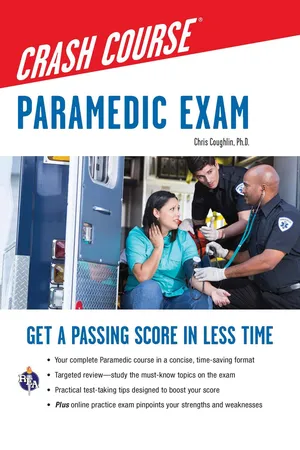
- 352 pages
- English
- ePUB (mobile friendly)
- Available on iOS & Android
Paramedic Crash Course with Online Practice Test
About this book
REA’s Paramedic Crash Course®
Everything You Need for the Exam – in a Fast Review Format!
From the Author of REA’s Best-selling EMT Crash Course®
REA’s Paramedic Crash Course® is the only book of its kind for the last-minute studier or any prospective Paramedic who wants a quick refresher before taking the National Registry Paramedic (NRP) Exam.
Targeted, Focused Review – Study Only What You Need to Know
Written by Dr. Christopher Coughlin, an EMS Program Director and paramedic with 27 years of experience, Paramedic Crash Course® relies on the author’s careful analysis of the exam’s content and actual test questions. It covers only the information tested on the exam, so you can make the most of your valuable study time.
Our fully indexed targeted review covers all the official test categories including airway and breathing, medical emergencies, trauma, special patients, and EMS operations.
Expert Test-taking Strategies
Our experienced author explains the structure of the exam, so you know what to expect on test day. He also shares detailed question-level strategies and shows you the best way to answer questions. By following our expert tips and advice, you can score higher on every section of the exam.
Full-length Online Practice Exam
The book comes with a true-to-format online practice test with diagnostic feedback, topic-level scoring, and detailed answer explanations to help students gauge their test-readiness.
No matter how or when you prepare for the Paramedic Exam, REA’s Paramedic Crash Course® will show you how to study efficiently and strategically, so you can get a great score!
Frequently asked questions
- Essential is ideal for learners and professionals who enjoy exploring a wide range of subjects. Access the Essential Library with 800,000+ trusted titles and best-sellers across business, personal growth, and the humanities. Includes unlimited reading time and Standard Read Aloud voice.
- Complete: Perfect for advanced learners and researchers needing full, unrestricted access. Unlock 1.4M+ books across hundreds of subjects, including academic and specialized titles. The Complete Plan also includes advanced features like Premium Read Aloud and Research Assistant.
Please note we cannot support devices running on iOS 13 and Android 7 or earlier. Learn more about using the app.
Information


Table of contents
- Cover
- Title Page
- Copyright Page
- Contents
- About Our Book
- A Letter from Our Author
- About Our Author
- About REA
- INTRODUCTION
- PART I PHARMACOLOGY
- PART II AIRWAY/ASSESSMENT/BLEEDING AND SHOCK
- PART III MEDICAL EMERGENCIES UNIT 1
- PART IV MEDICAL EMERGENCIES UNIT 2
- PART V TRAUMA
- PART VISPECIAL PATIENTS
- PART VIIEMS OPERATIONS
- APPENDIX: THE PARAMEDIC PSYCHOMOTOR EXAM